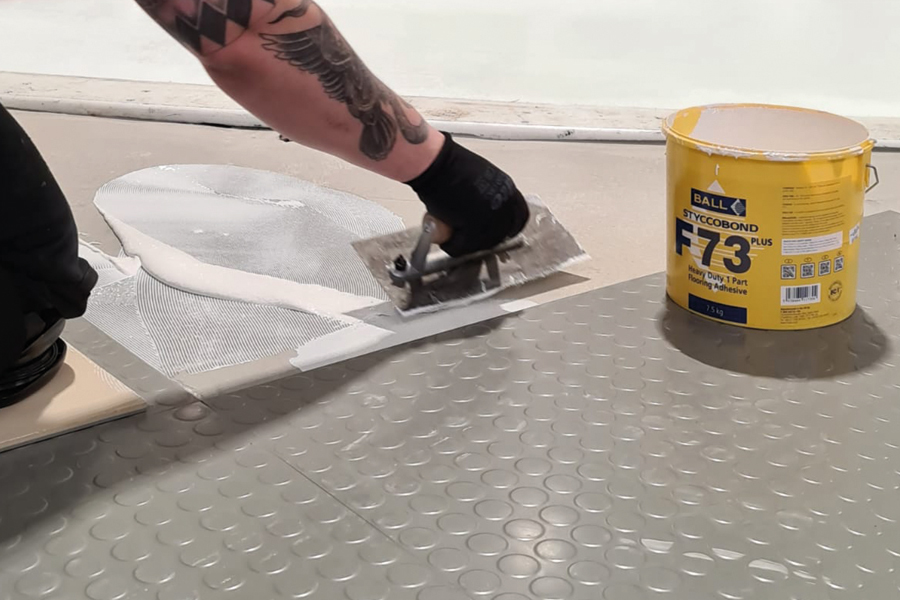NEIL Sanders, technical director at F Ball and Co, says there are ways to achieve a long-lasting, aesthetically pleasing floor finish when installing rubber and linoleum floorcoverings, including proper subfloor preparation and the selection of an appropriate adhesive.
Says Neil: ‘As with all flooring installations, contractors working with rubber or linoleum should first ensure that subfloors are suitably sound, clean and dry. A moisture measurement test should be undertaken to determine the relative humidity (RH) levels of the subfloor.
‘If RH levels are 75% or above where resilient floorcoverings will be installed, the application of a waterproof surface membrane will be required to suppress excess moisture within the subfloor and prevent floor failure.’
Priming
With a few exceptions, it’s essential to prime the subfloor before proceeding to the next stage of installing floorcoverings. ‘Priming promotes adhesion between non-absorbent subfloors and subsequently applied smoothing compounds or adhesives. When used over absorbent surfaces, priming promotes adhesion as well as stopping the unacceptably rapid drying of adhesives or smoothing compounds.
‘A smoothing compound should then be used to create a smooth and level surface for the receipt of new floorcoverings. Thin resilient floorcoverings are more susceptible to letting imperfections in the subfloor show through.’
Adhesive selection
Neil points out that an adhesive should then be selected that’s compatible with the floorcoverings and the environment in which they’re being installed. Every flooring project presents unique challenges.
‘The properties of rubber and linoleum necessitate the use of specialist adhesives, which will ensure that a strong, long-lasting bond is achieved between the floorcovering and subfloor.
‘Adhesives with high initial grab also make the installation process easier. Ongoing research and development has led to the creation of adhesives for rubber and linoleum floorcoverings with a range of other specialist properties.’
Outdoor installations
Rubber floorcoverings are a popular choice for outside flooring installations because they’re durable and won’t be damaged by water. Traditionally, flooring contractors installing floorcoverings in such environments would require a polyurethane or epoxy-based adhesive.
Neil continues: ‘Advancements in adhesives technology enabled F Ball to create Styccobond F73 PLUS, a one-part, moisture-curing alternative to polyurethane and epoxy adhesives for internal and external heavy-duty applications.
‘The adhesive provides the high bond strength required to hold a wide range of textile and resilient floorcoverings, including rubber, vinyl, linoleum and synthetic grass, firmly in place in areas that will be subject to surface water, as well as heavy loads and high foot traffic. Once cured, it’s resistant to water, oil and grease.
‘It’s also faster curing than traditional alternatives, requiring as little as 90 minutes to secure floorcoverings. Its fast-setting properties allow welding of sheet floorcoverings to take place from as little as two hours.’
Rubber floorcoverings
Rubber floorcoverings are widely used and a popular choice for schools, sports settings and even ships because they are durable, easy to clean and maintain and offer good grip in wet conditions. The strong initial tack and high bond strength of specialist rubber floorcovering adhesives makes them ideal for securing a wide range of rubber sheet and tile floorcoverings.
Such adhesives have a high film strength to provide good dimensional stability and prevent the rubber floorcovering from moving when subject to heavy traffic.
Says Neil: ‘F Ball’s advanced Styccobond F58 PLUS is a fast-drying, fibre-reinforced, pressure sensitive adhesive that enables rubber and vinyl sheet and tile floorcoverings to be secured from just five minutes following application.
‘The product transitions from a wet-lay adhesive when initially applied to a subfloor to become fully pressure sensitive, allowing contractors to utilise the benefits that most suit their requirements. Reinforcing fibres in the formulation provide resistance to lateral movement, reducing the potential for floorcoverings sliding during installation.
‘Available in 15L and 5L units, and with coverage rates of up to 6sq m per litre, the adhesive also offers over 20% more coverage than similarly packaged products sold by the same number of kilograms.’
Linoleum floorcoverings
When working with linoleum floorcoverings, F Ball recommends the use of an adhesive that provides high initial grab and has been specially designed to adhere linoleum.
To be able to adhere hessian-backed linoleum floorcoverings, an adhesive must be able to ‘wet out’ the backing (ie transfer enough adhesive to create a good bond and deliver the instant grab that reduces the sliding of the linoleum when being installed).
Says Neil: ‘Specialist non-flammable, acrylic emulsion adhesives for linoleum floorcoverings include F Ball’s Styccobond F54, which is solvent-free, protected against biodegradation and suitable for use over normal underfloor heating systems.’
Compatibility check
Neil concludes: ‘F Ball recommends that contractors always check the compatibility of particular floorcoverings and adhesives. To do this, you can consult the floorcovering manufacturer’s guidelines. Alternatively, F Ball produces a Recommended Adhesives Guide (RAG), which lists adhesives recommended for use with floorcoverings produced by over 200 manufacturers. The guide is available as a free app or a printed booklet. An interactive version can also be found on the F Ball website.’
www.f-ball.co.uk
Please click to view more articles about
> F Ball <

